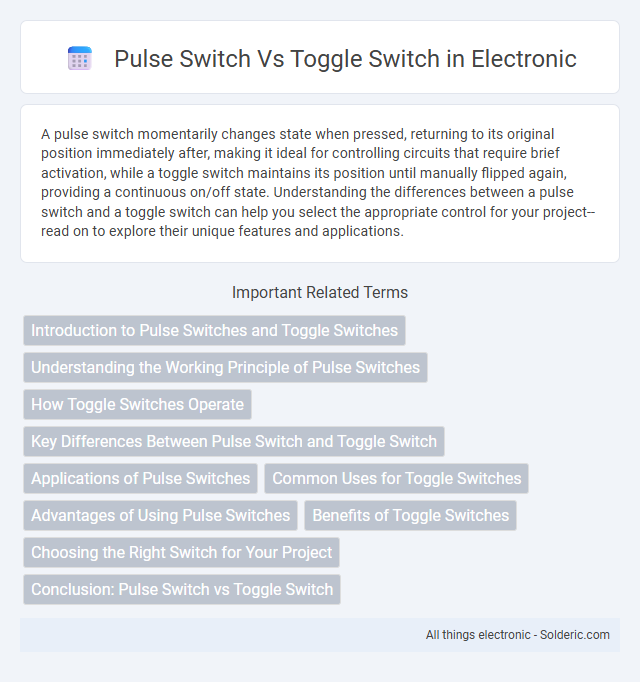A pulse switch momentarily changes state when pressed, returning to its original position immediately after, making it ideal for controlling circuits that require brief activation, while a toggle switch maintains its position until manually flipped again, providing a continuous on/off state. Understanding the differences between a pulse switch and a toggle switch can help you select the appropriate control for your project--read on to explore their unique features and applications.
Comparison Table
| Feature | Pulse Switch | Toggle Switch |
|---|---|---|
| Operation | Momentary contact; returns to default position after press | Maintains position until manually changed |
| Function | Used for short, momentary signals or triggering actions | Used for continuous on/off control |
| Applications | Doorbells, reset buttons, control circuits | Light switches, power switches, selection inputs |
| Contact Type | Normally open or normally closed momentary contacts | Maintained open or closed contacts |
| Durability | Designed for frequent, brief use | Suitable for sustained use in on/off positions |
| Size & Design | Compact, push-button style | Lever or rocker design, larger footprint |
| Example Brands | Omron, Cherry, Eaton | Leviton, Siemens, Honeywell |
Introduction to Pulse Switches and Toggle Switches
Pulse switches, designed to send momentary electrical signals, are widely used in applications requiring short, controlled activations, such as relays and lighting circuits. Toggle switches maintain a stable position to control the flow of electricity, making them ideal for devices needing a constant on/off state like household appliances and industrial machinery. Understanding the operational differences between pulse switches and toggle switches is essential for selecting the appropriate control mechanism based on application requirements.
Understanding the Working Principle of Pulse Switches
Pulse switches operate by momentarily connecting a circuit only while being pressed, sending a brief electrical signal before returning to the off position. Unlike toggle switches, which maintain a continuous on or off state until manually changed, pulse switches use a spring mechanism to ensure they automatically reset. Understanding this working principle helps you select the right switch for applications requiring momentary control or signaling.
How Toggle Switches Operate
Toggle switches operate by manually flipping a lever back and forth to open or close an electrical circuit, maintaining a stable on or off position until changed. They rely on mechanical contacts that physically connect or disconnect wires, providing reliable, easily visible control for power flow. This on-off mechanism contrasts with pulse switches, which send a brief signal without sustaining a connection.
Key Differences Between Pulse Switch and Toggle Switch
Pulse switches momentarily make or break an electrical circuit when pressed, ideal for applications requiring short, momentary signals. Toggle switches maintain their position until manually changed, providing a steady on or off state suitable for continuous power control. Your choice depends on whether you need a temporary or a permanent switch position in your device's operation.
Applications of Pulse Switches
Pulse switches are extensively used in applications requiring momentary electrical contact, such as reset buttons, doorbell systems, and keyboard keys, where a brief activation triggers a response without maintaining a continuous circuit. Their design facilitates control in automated systems, including PLC inputs and industrial machinery, by sending short pulses to initiate specific actions or signals. Pulse switches enhance safety and efficiency in systems that must avoid sustained current flow, making them ideal for time-sensitive operations and low-power electronic devices.
Common Uses for Toggle Switches
Toggle switches are widely used in automotive applications, industrial machinery, and household appliances due to their simple on/off functionality and durability. They are favored for controlling lighting, power tools, and HVAC systems because of their easy installation and clear operational positions. The robust design of toggle switches makes them ideal for environments requiring reliable manual control and frequent switching.
Advantages of Using Pulse Switches
Pulse switches offer precise control by sending momentary signals, reducing the risk of switch wear and increasing durability compared to toggle switches. They enable seamless integration with electronic systems for automation and remote control, enhancing operational efficiency. Pulse switches also minimize power consumption by activating circuits only briefly, making them ideal for energy-sensitive applications.
Benefits of Toggle Switches
Toggle switches offer durable operation with clear on/off positions, ensuring reliable control in various electrical applications. Their simple design allows for easy installation and maintenance, making them ideal for both residential and industrial use. You benefit from their tactile feedback and consistent performance, which minimize accidental activations and enhance user experience.
Choosing the Right Switch for Your Project
Pulse switches provide momentary activation by completing the circuit only when pressed, making them ideal for applications requiring temporary signals or reset functions. Toggle switches maintain their position when flipped, offering reliable on/off control for continuous power or settings. Your choice depends on whether your project needs brief or sustained activation, balancing functionality with user interaction.
Conclusion: Pulse Switch vs Toggle Switch
Pulse switches offer momentary activation ideal for applications requiring brief or timed signals, providing precise control and reducing wear from constant engagement. Toggle switches deliver sustained on/off states suitable for simple, robust circuit control with clear visual feedback of position. Selecting pulse or toggle switches depends on application needs, balancing momentary function versus steady state operation.
pulse switch vs toggle switch Infographic

 solderic.com
solderic.com